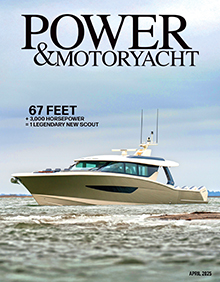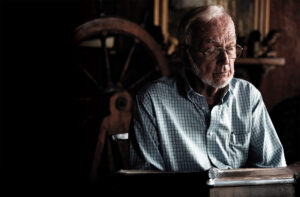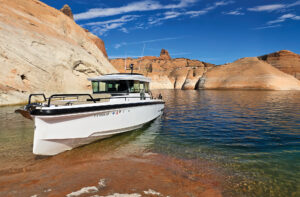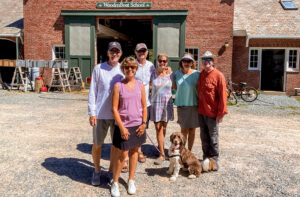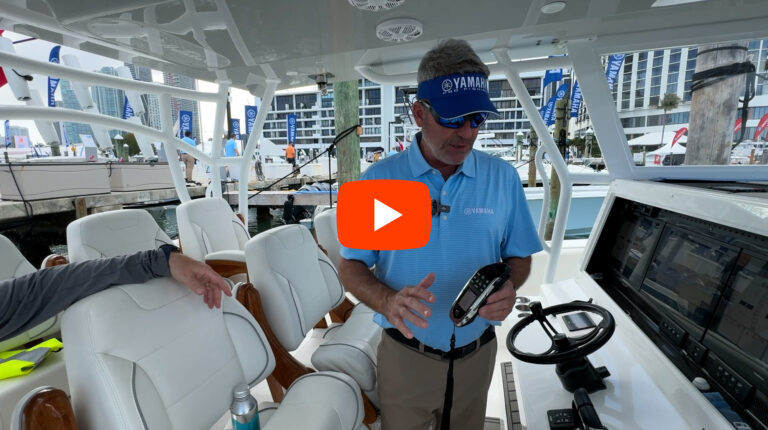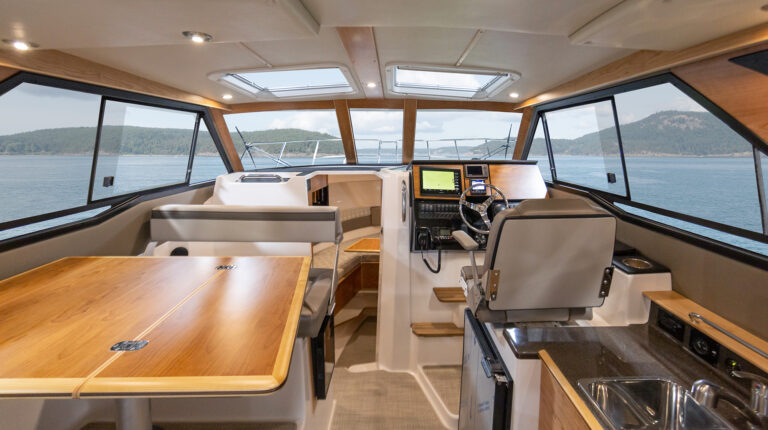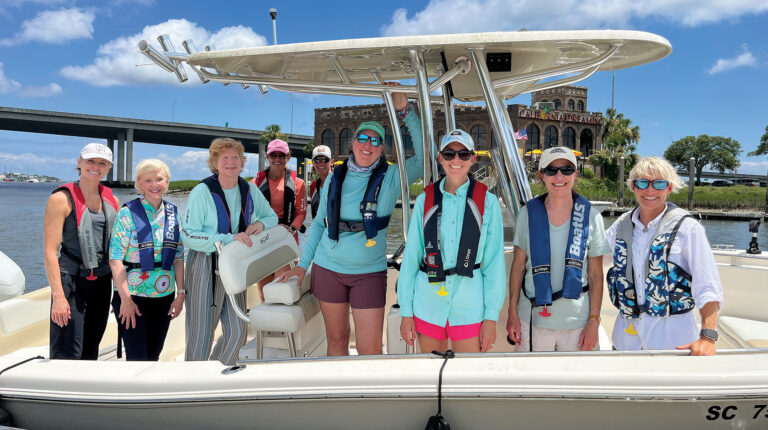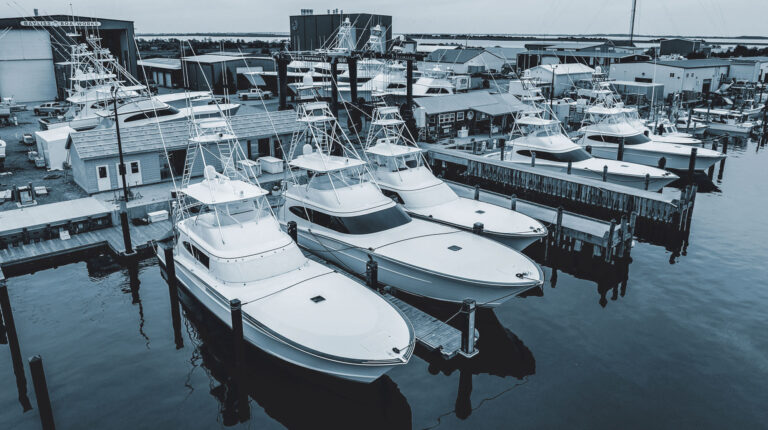Photography by George Sass, Sr.
Three Days 1,000 Islands
Get a deep sense of place and a healthy dose of applied local knowledge with a cruise along the U.S.-Canadian border between Ontario and New York State.

Years ago our family spent weeks cruising the “30,000 Islands” in Canada’s Georgian Bay. Exploring the crystal-clear waters dotted with thousands of pink-granite islands was an unforgettable adventure. Captivated by island cruising we later explored the “10,000 Islands” off southwest Florida. It’s a National Wildlife Refuge, and true to form, we found the thick mangroves and sandy beaches teeming with wildlife. So it seemed only natural to continue our island odyssey by cruising the “1,000 Islands” that span Ontario and New York along the St. Lawrence River.

See more photos from our cruise
of the Thousand Islands here ➤
The locals here love to explain what differentiates an island from a big rock: “An island must be big enough to support at least one tree and remain above the water level year-round. Anything else is just a rock.” Technically, there are about 1,800 islands in this area. What surprised us is how many of these “one-tree islands” have a house built on them. Most homes are modest in size, but the 360-degree views are spectacular, and one doesn’t have to worry about neighbors. Many of the publicly owned islands offer boaters a place to land and a variety of things to do. Whether hiking, paddling, visiting museums, or indulging in haute cuisine, there’s plenty for the entire family to enjoy.
We begin our exploration in Kingston, Ontario, after a 30-mile passage across Lake Ontario from Henderson Harbor, New York. Having previously experienced the rough seas the Great Lakes are capable of, we are not surprised to have a bumpy ride with 5-foot seas on our beam. After tying up at Kingston’s Confederation Basin Marina, we check in with Canadian Customs using a special phone at the end of the dock. The Customs agent is polite, efficient, and friendly, and we’re good to go in five minutes.
Equidistant from Montreal and Toronto, Kingston is a city of 125,000 with impressive 19th-century architecture and a full calendar of cultural activities. Known as the Limestone City for its historic buildings made of local limestone, it is a popular stopover for those traveling the Rideau Canal, a key route of The Great Loop. This is a vibrant, attractive, friendly city. Later that night we take the advice of locals and enjoy excellent French cuisine at Chez Piggy.
Next morning we head up the Bateau Channel between the mainland and Howe Island, stopping for fuel in Gananoque, a picturesque village 17 miles east of Kingston. South of us are the Admiralty Islands, which offer several anchoring possibilities. While we are now in Canadian waters, we have been warned not to wander into U.S. waters without checking in. So, we plan our route to remain on the Canadian side until we are ready to return to the States. There are areas where Canadian and U.S. islands are quite close, and since they share the same geological properties, it’s easy to wander mistakenly from one country to the other.
We drop anchor off Sugar Island, which, while in Canadian waters, has been owned by the American Canoe Association for more than 100 years. Invited by friends who own a campsite here, we hike across the island and discover that most “residents” are summer tent campers. The few cabins are self sufficient, as there is no electricity or running water. Staying here every year are a number of hardy sailors who compete in International Canoe Sailing events, and we get to see these extreme sailing canoes perform their high- wire acts. Later that day we move to another anchorage off nearby Camelot Island, part of Parks Canada. We pay our $6 dinghy-landing fee at an unattended ranger station and spend the afternoon hiking across this rugged, magnificent island. As late afternoon approaches, the anchorage becomes crowded, so we head east and drop our hook off Mulcaster Island, part of the Navy Island group.

Cruising Costs for 3-Days
We now cruise on a trailerable, outboard powered 30-foot cruiser, so our costs for marinas and fuel are minimal. Here’s a summary of what this 3-day cruise cost us.
Provisions purchased in Henderson Harbor: $175
Day One: Kingston
Confederation Basin Marina: $65
Dinner for two at Chez Piggy: $100
Canadian Courtesy Flag: $7
Total: $172
Day Two: Mulcaster Island Anchorage
Fuel (gas) at Gananoque (50 gallons): $275*
Dinghy landing fees for two islands: $12
Breakfast, lunch, and dinner onboard: N/A
Total: $287
(Overnight mooring ball fees are $20. Docking fees are $1/foot.)
Day Three: Boldt Castle & Clayton, New York
Castle Admission for two: $17
Islander Marina: $65
Dinner for two at Bella’s: $85
Total: $167
Grand Total: $626
*The distance from Kingston to Clayton, New York is approximately 60 miles. Because the islands are so close together, we often cruised at displacement speeds of 7 knots, burning less than 2 gph. We normally cruise at 22 to 25 knots and burn 10 gph.
Resources:
Antique Boat Museum, Clayton, New York ➤
Boldt Castle ➤
Thousand Islands cruising resources ➤
Most publicly owned islands have small “crib docks” that accommodate three or four boats, and some also provide a limited number of mooring balls. Because there is no electricity, many boaters bring along portable generators and, to our chagrin, run them for hours. Surprised to find the docks full and moorings taken, we ask a park ranger about the crowded conditions. He explains that we’ve chosen the busiest time of the year to visit because it is “Construction Holiday” in Quebec, an annual, two-week period during the second half of July. Every year since 1971, the entire construction industry takes these two weeks off, and much of Quebec follows suit. As a result, the waterways are packed with French boaters, many of whom seem determined to party until they drop. But there are over 1,000 islands, and we are able to find peace and quiet by staying off the beaten path.
Early the next morning we hike through Mulcaster’s woods of pine, hemlock, beech, maple, and oak, and the paths of soft pine needles and moss beds are soothing to our feet. We come upon scenic campsites overlooking the water and a clearing where several boats are tied to a crib dock. Picnic tables have been moved together, and families have gathered for breakfast. Enjoying the great outdoors is what cruising here is all about.
We could have spent a week or more exploring these islands, but we are scheduled to meet friends in Clayton, New York, for the Annual Antique Boat Show & Auction. Arriving on Heart Island, we check in with U.S. Customs, a 10-minute procedure, and then tour the fascinating Boldt Castle. Before construction started in 1900, George Boldt, owner of the Waldorf Astoria, had the island blasted into the shape of a heart as a sign of affection for his wife. Sadly, construction was halted upon her untimely death. Today it is owned by the Thousand Islands Bridge Authority, and it is well worth seeing.
Our 1,000 Island cruise ends all too quickly in Clayton, New York. After getting a slip, we take a short walk to the Antique Boat Museum, which is hosting the Annual Boat Show and Auction. Having owned a wooden yacht, we are in awe of the beautifully restored boats built by Chris Craft, Garwood, Hacker-Craft, Century, Lyman, and more, some of which date back to the early 1900s. The museum offers informative exhibits on building and restoring these nautical treasures, and we gladly become members to help support its admirable work.
This short cruise of the 1,000 Islands has whet our appetite. There are more islands and parklands to discover, all within the protected waters of the St. Lawrence. Villages like Gananoque, Alexandria Bay, and Sackets Harbor beckon, and we look forward to seeing the quaint homes and galleries on Wellesley Island. Next time, though, we’ll plan our visit to avoid the crowds of Quebec’s Construction Holiday.

Thousand Islands Photo Gallery
This article originally appeared in the April 2014 issue of Power & Motoryacht magazine.

